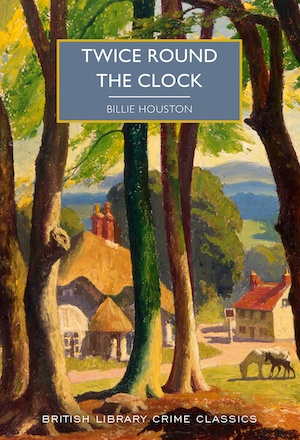
Horace Manning is a sinister madman. He is also a scientific genius. This combination of characteristics provides an indication of danger from the outset of Billie Houston’s Twice Round the Clock, although surprisingly, despite an atmosphere of evil hanging around him like a fog of stale tobacco smoke, Manning turns out to be the victim of murder rather than the perpetrator.
Houston reveals as much in the prologue and then winds the clock back 12 hours to explain what occurred in the lead-up to the crime.
It all starts with a marriage proposal. Or, rather, with Anthony Fane approaching Horace Manning to ask permission to marry his daughter, Helen. Given that Horace frightens and disconcerts all those he encounters, it comes as a great surprise to Anthony that he immediately agrees to the marriage, proclaiming it to be ‘Excellent!’. Horace even suggests that Anthony and his friends and family come to dine that evening in celebration of the engagement.
The scene appears set for a classic country house mystery.
Indeed, a fraught yet overly polite gathering worthy of Agatha Christie, Ngaio Marsh, Cyril Hare and other Golden Age writers ensues. Guests and servants are introduced, secrets are hinted at, and Horace’s evil is made vividly clear. The house is even cut off from the outside world by a severe rainstorm. At the end of the 12 hours, Horace is found dead in his study, stabbed in the back with a carving knife in just such a way as to kill him instantly.
However, while most of Twice Round the Clock takes place within the walls of Treeholme, Horace’s country estate, the second part of the book deviates from the conventions of the puzzle mystery and enters thriller territory. Still, during the 12 hours after Horace’s death, his guests attempt to determine who killed him, fully aware that they are trapped in the house with a murderer.
Author Billie Houston emphasises the passage of time throughout the story. This serves to build tension ahead of the murder and then to enhance the feeling of frenzy and danger in its aftermath. As the facts of the murder are established from the outset, as the clock ticks towards the appointed time, the sense of dread becomes increasingly palpable. The majority of characters have no idea that a death is coming, but they nevertheless appear nervous and anxious.
The effects of time are enhanced by Houston’s skill at establishing atmosphere. Here, she follows the approach of John Dickson Carr rather than the aforementioned authors and leans towards the macabre. There’s nothing paranormal going on at Treeholme, but there’s definitely something not quite right about the place. The half-explained behaviours of Horace Manning and the implied secrets from the past hint at something frightful or horrific.
This atmosphere of Gothic horror is further highlighted by several disturbing events that occur beyond the murder. The sleepwalking housekeeper appears to guests as a ghostly apparition clutching a knife, while the unfortunate butler is disfigured by a vitriol-laced booby trap. There’s darkness here beyond that found in the typical country house mystery.
Houston also steps beyond the bounds of classic crime in her description of Horace’s work. He is a famous scientist who specialises in the development of deadly gases and, while most of his aberrant behaviour is suggested to be psychological torture that cannot be fully grasped or described by those who experience it, his sadism is made manifest when he tests his latest creation on one of the housekeeper’s kittens. He forces his guests to watch this deadly experiment.
While Twice Round the Clock was published in 1935, when animal testing was a much more accepted practice, Horace’s wanton cruelty appals his guests. They break the conventions of guest-host behaviour and remonstrate with him, attempting to save the kitten. Kay Fane takes the lead here, which provides really the sole opportunity for a female character to shine. Otherwise, Houston relegates her female characters to damsel-in-distress/romantic roles. It’s one convention from the time that she sadly doesn’t break.
The idea of Horace as a mad scientist working on deadly gases that could be weaponised is what drives the thriller-related aspects of the story. It also opens up the possibility of the involvement of foreign powers in his murder. Tensions were building in Europe in 1935 and there was a justified fear of war. The characters’ concerns regarding the possible uses of Horace’s discoveries mirror the worries of real people at the time about the potential of war and its likely consequences.
This realism tempers the more outlandish elements of the story and renders events more relatable to modern readers. So too does Houston’s description of the vivisection, as without it the nature of Horace’s ‘madness’ may have remained elusive due to largely being based on inappropriate behaviours (such as maintaining eye contact for too long) and disregard for social conventions. Of course, this equivalence of ‘evil’ and ‘madness’ is horribly wrong and dated and has to be considered in light of the period in which the book was written.
Martin Edwards notes in his introduction to this edition of Twice Round the Clock that Houston was a big fan of crime fiction, and it seems that she might have sought to use many of her favourite elements of the genre in her only novel. The resulting mashup of a murder mystery and a thriller doesn’t quite hang together. The thriller approach adds action and danger to the story, but this happens at the expense of the amateur detective angle.
Altogether, Twice Round the Clock is certainly not without flaws, particularly in terms of characterisation and plot coherence, but it does offer an intriguing murder mystery that reflects the norms and concerns of its time. Based on this first outing, it’s a shame that Houston – a famous actor and dancer in the 1930s – didn’t go on to write further mysteries.
For other rediscovered crime classics, try Bernard J Farmer’s Death of a Bookseller or ECR Lorac’s These Names Make Clues.
British Library Publishing
Print/Kindle
£7.16
CFL Rating: 3 Stars










